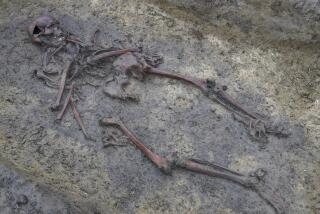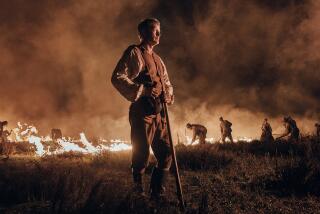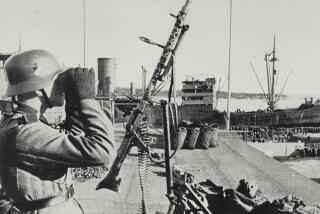Scandinavian Roots : Viking Ghosts : Haunting 700-Year Old Norse Burial Grounds Near Denmark’s Appealilng Aalborg
ALBORG, Denmark — I’m standing alone on a wind-swept hill, sleet stinging my ears. Black storm clouds race in from the North Sea and Denmark’s Limfjord is a gray blur in the distance. Why am I drawn to this utterly desolate spot time and again?
Because beneath my feet are the ancient graves of almost 700 Vikings, some marked with large stones set in patterns shaped like boats. This hill, called Lindholm Hoje, is the largest known Viking burial ground, resting place of seafaring warriors who died between the 5th and 11th centuries. I find the bleak landscape mysterious and alluring, and its history captures my imagination.
Archeologists who excavated the settlement and graveyard at Lindholm Hoje between 1952 and 1956 found few human remains--most of the bodies were cremated--but many insights into Viking culture. One grave contained both a crucifix and a Thor’s hammer, a common pagan amulet, evidence of the painful Norse transition from the old gods to the new Christian religion between the 9th and 11th centuries. Some graves held coins from as far away as Arabia, testament to the immense area the Vikings roamed. Others contained intricate weavings and delicate silver jewelry, reflecting Viking artistry and appreciation for beauty.
But there is more than Viking ghosts to haunt visitors to this area on the northern tip of the Jutland peninsula, a full day’s trip northwest from Denmark’s better-known capital, Copenhagen. Just a 20-minute bus ride from Lindholm Hoje over the bridge across the Limfjord, the strip of water that slices through the tip of the peninsula, is Aalborg, which has come to be one of my favorite Danish cities.
With a population of 155,000, Aalborg is Denmark’s fourth largest city, a modern commercial, industrial and shipping center with a fascinating Renaissance heart, streets perfect for strolling, and the home of the famous Aalborg aquavit, the Scandinavian liquor with the walloping punch. And Aalborg has many interesting ghosts of its own: The historic quarter near the waterfront has a sprawling manor house where a once-secret society gathered, a lively street of pubs and restaurants named after a local witch, and an ancient monastery that’s said to be spooked.
This is a particularly good time to visit Aalborg since 1992 marks what the city calls its “2 x 650 Anniversary.” That slightly-less-than-sexy title refers both to the 650 years since Danish King Valdemar Atterdag granted Aalborg its first charter, and to the 1,300 years since the Vikings settled at Lindholm Hoje. Commemorative concerts, sporting events and exhibitions are taking place all year. Of particular note in Aalborg is “When Gods Were Gods and Heroes Were Heroes,” a multimedia exhibition on Nordic mythology at the North Jutland Museum of Modern and Contemporary Art. And at Lindholm Hoje, a new ultra-modern museum devoted to Viking archeology has recently opened.
Aalborg itself has a more modern Nordic history that’s just as fascinating. Perhaps the most treasured building in all the city--and my personal favorite--is Jens Bang’s house. It would be hard to miss this magnificently ornate five-story manor on Osteraa street, in the middle of the Old Town. It was built in 1642 by the city’s wealthiest merchant, a vain fellow who was so rich he actually loaned money to King Christian IV, Denmark’s castle builder.
Jens Bang’s house has been used as a pharmacy for three centuries. But the basement wine cellar has been preserved and is possibly the most popular rendezvous spot in town. The Duus Wine Cellar imparts a luscious sense of Old Aalborg, with its open fireplaces, candlesticks on every table and wine tapped from oak kegs. The once-secret Guild of King Christian IV has been meeting here since 1942, when the locals sandbagged the entrance and set up a club closed to the occupying Nazi troops. It was named after the monarch who was indebted to Jens Bang, and his monogram, C IV, is stamped into each member’s key, a coveted status symbol.
I met one key-holder, Kiss Struckmann, on my most recent visit to Aalborg last February. It was pouring rain and I had ducked into the tourist office. Struckmann, a kind-hearted, 50ish woman who used to work at the local newspaper and now escorts tour groups around the city, seemed amused when I mentioned my slavish interest in Aalborg’s Viking ghosts. She decided my horizons needed broadening and offered to give me an insider’s tour. I gladly accepted.
Being squired around by Struckmann was like being handed the keys to the city, literally. In addition to the guild key, she has a ring of keys fitting some of the most interesting doors in Old Aalborg. First she opened the former Monastery of the Holy Ghost, dating from 1431. Today the monastery, not far from Jens Bang’s house, is used as a retirement home, but some chambers are preserved in their original states and can be seen by guided tour groups (the local tourist board arranges visits).
Struckmann told me that this unusual monastery housed both monks and nuns--separated by a high wall. My new friend said she likes to tell her tour groups the story of the nun who was plastered inside one of the columns after being caught sneaking into the monks’ rooms. Several locals swear they’ve seen the nun’s ghost, which evidently tends to appear whenever wine is uncorked at banquets held in the monastery.
Each chamber holds a kernel of history, explained Struckmann, unlocking a row of ancient, heavy doors. In one chamber, guns for the Danish underground resistance were hidden. Murals in other chambers depict bizarre, supposedly biblical, scenes such as a headless horseman (if you look closely, you’ll spot the rider’s head beneath the horse’s tail) and the temptation of St. Anthony by a beautiful lady (a hint of her devilish origins are her feet--attached backward).
Visible from all over Aalborg is the baroque spire of Budolfi Cathedral, but I had never gone inside until Struckmann beckoned me. Budolfi is a pastiche of styles from centuries of rebuilding. The oldest part dates to 1060. A series of paintings from around 1500 depicts the Ten Commandments, with quirky detail for the benefit of the illiterate population of the time. Struckmann thinks of the series as an early comic strip.
Because of my interest in Vikings, Struckmann insisted I revisit the Aalborg Historical Museum next to the cathedral. The museum’s prized permanent exhibit is a richly carved, oak-paneled room from 1602, preserved from the Osteraa street home of one of Jens Bang’s contemporaries. But there also was a special display on the Vikings, with case after case of combs. Yes, combs.
“The Vikings were actually very well-groomed,” Struckmann informed me. “The women of the British Isles liked them because they bathed every day.” That seemed a bit far-fetched, but I was delighted that my friend was proving to be a wealth of obscure data.
Aalborg’s civic pride and joy is the North Jutland Museum of Modern and Contemporary Art. The noted Finnish architect Alvar Aalto designed the building, which features works by well-known Scandinavian modern artists. Struckmann instructs tourists, “If you don’t like the paintings, at least like the building.”
Travelers who are not fortunate enough to have Struckmann as their guide can still commune with locals along Jomfru Ane Gade, a cobbled street ( gade ) lined with 25 restaurants and pubs. It’s named for a 17th-Century Aalborg woman who supposedly ran a school of potion-brewing and spell-casting for other bourgeois women. Being of noble blood, Ane could not be burned at the stake; instead she was sent to Copenhagen for beheading, and her body was returned for burial in Aalborg’s Sonderholm Church--a rare distinction for a convicted witch.
Today’s revelers on Jomfru Ane Gade maintain a lively interest in potions, especially around happy hour, when beer is on special (it normally costs $5 to $6 per glass throughout high-priced Scandinavia). As dinner time arrives, everyone has the task of deciding on one of the street’s many restaurants. Perhaps the best is Faklen, an elegant and--at $50 per person without wine--pricey gourmet choice. Also good but less stuffy are Regensen, where the specialty is steak served on a piping hot iron plate, and Fyrtojet, an airy, glass-roofed garden room where Danish dishes such as herring, frikadeller (meatballs) and open-faced sandwiches are served.
I prefer to dine away from the crowds on Jomfru Ane Gade on quieter side streets such as Ved Stranden, where there are cozy Lebanese, Greek, Italian and Danish eateries. With more than 300 Aalborg restaurants to choose from, I’d be hard-pressed to single out a favorite. But for breakfast, Slotshotellet can’t be beat with its enormous buffet of herrings, cold meats, cheeses and home-baked breads.
Jomfru Ane is one of several pedestrian streets in the city center. Wander down any of them to browse the department stores, boutiques and tempting konditoris , or pastry shops. These bakeries have tables where you can sample a pastry over tea or coffee. What we call “Danish” bears little resemblance to what the Danes call wienerbrod . The many kinds of wienerbrod --twisted in cinnamon and studded with raisins or loaded with homemade marzipan--are unfailingly fresh, rich and satisfying.
One konditori waiter apologized profusely for his poor English (most Danes have an excellent command of the language) and jumped from behind the counter to carry my tray to a choice table by the window, gallantly pulling back my chair. Friendly little gestures like this are typical in Denmark, a country where Americans are well liked and welcomed.
Early in the day I had arrived on the night train and just as I was aching for coffee, I discovered I’d run out of kroner, Danish money. The banks wouldn’t be open for hours. “Don’t worry, I’ll change your dollars,” said a young woman at the railway station ticket counter. And she did, taking not a krone in commission. Later a bus company employee walked me over to a rival line because it offered a better schedule. Danes are noted businesspeople, but they also have a heart.
Being perhaps the most continental of all Scandinavians, Danes are also noted for indulging in sensual pleasures. The Scandinavian Tobacco Co. in Aalborg makes the cigars and cigarillos that Danes of all ages seem to relish. At first it’s startling to see grandma puffing away on a big stogie, but you get used to it.
While Americans campaign against smoking, in Aalborg it’s not considered antisocial to light up anywhere. One restaurant hostess offered me a cigarette from a big silver tray “on the house” and seemed astonished when I declined.
Aalborg’s most famous industry involves finessing ordinary potatoes into Scandinavia’s magical brew, aquavit, which means “water of life” (and is spelled akvavit in Denmark). Aquavit--or as the Danes more often call it, snaps --has been commercially distilled in Aalborg since 1846. The Danish Distilleries factory near the port has massive tanks, big as water towers, a separate one for each of the 13 labels of snaps .
“There’s a potato in every glass,” according to Kiss Struckmann. Some 18,000 liters of liquor are produced daily. The best-seller is the clear, high-octane Aalborg Taffel (also called Red), but the mellow, amber-colored Harald Jensen is favored by connoisseurs.
It was my turn to be astonished when Struckmann turned down my invitation for a mid-morning snaps --I’ve never known a Dane to refuse one. She explained she wouldn’t be able to drive. I couldn’t argue with that since Scandinavians have some of the world’s toughest drunk-driving laws.
If you’re dining out, take a cab and don’t miss the chance to wash down a plate of Danish herring with an icy glass of snaps . The Danes chase it with beer--preferably a Tuborg or Carlsberg. A liter aquavit bottle from the corner shop will set you back at least $22; snaps is cheaper in the duty-free shops on the North Sea ferries.
When drinking aquavit, it’s important to toast properly. Raise your glass to eye level, say skaal, nod to your companions, then belt down the entire thing. Before returning the glass to the table, hold it at eye level once again and nod to your companions. This tradition is said to have survived from Viking times, when it was a wise idea to keep an eye on one’s tablemates. (The notion that the word skaal derived from some Viking penchant for quaffing from the skulls of vanquished foes is groundless; the toast comes from the Old Norse skal , meaning bowl.)
After hours of learning the “insider’s Aalborg,” I implored Struckmann to take me back to the Viking mound. We climbed to the remote spot and silently pondered the age-old stone graves at Lindholm Hoje, where 1,300-year-old spirits still roam.
GUIDEBOOK: Haunting the Streets of Aalborg
Getting there: SAS is the only airline that flies nonstop daily from Los Angeles to Copenhagen. There are many daily air connections from Copenhagen to Aalborg, a 45-minute flight. You can also go by motor coach or intercity train; on my last trip I took the overnight train from Copenhagen, which arrives in Aalborg about 6 a.m. Several daily ferry connections are available from ports in Sweden and Norway to Frederikshavn, north of Aalborg. If you’re driving from the Continent, take the E45 from Germany; Aalborg is a five- to six-hour drive from the German-Danish border. To get to the Viking burial ground at Lindholm Hoje, take the No. 6 bus from downtown Aalborg. Cost is about $1.60 one way.
Sightseeing: If you’re interested in wandering through the dozen or so blocks of Old Aalborg on your own, pick up a brochure with maps from the Aalborg Tourist Bureau, 8 Osteraa; local telephone 981-26022, fax 981-66922. It’s in English and it’s free. On Mondays, Wednesdays, Fridays and Sundays from June 24 to Aug. 16, English-speaking guides lead tours of the area for about $1.60, starting at the square C.W. Obelsplads.
Museums: North Jutland Museum of Contemporary and Modern Art, 50 Kong Christians Alle; open 10 a.m.-5 p.m. (closed Mondays). Aalborg Historical Museum, 48 Algade; open daily 10 a.m.-7 p.m., June through August. Lindholm Hoje Museum, 11 Vendilavej; open daily 10 a.m.-5 p.m. (take bus No. 6 from downtown Aalborg). Shipping and Naval Museum, 79 Vestre Fjordvej (at the port); open daily 10 a.m.-7 p.m.
Where to stay: Built in a former 18th-Century manor house, the Phoenix (77 Vesterbro; from the U.S., telephone 011-45-981-20011, fax 011-45-981-63166) is an updated 179-room hotel with two restaurants, a pub, pastry shop and loads of character; double rooms are about $154. Business people favor Limfjordshotellet (14 Ved Stranden; phone 011-45-981-64333, fax 011-45-981-61747), a modern 180-room hotel in the city center near the port and Jomfru Ane Gade; doubles about $155. Hvide Hus--literally, “The White House” (2 Vesterbro; telephone 011-45-981-38400, fax 011-45-981-35122)--is a 16-story, 199-room hotel that once hosted George Bush. Although somewhat impersonal, it’s the best equipped in town, with a pool, sauna, restaurant and lobby shops; doubles about $166-$194. Slotshotellet--the “Castle Hotel” (5 Rendsburggade; telephone 011-45-981-01400, fax 011-45-981-16570)--has a comfortable, homey atmosphere and the best breakfast in town; doubles about $155. (All rates listed include breakfast and 25% tax and service.)
For more information: Contact the Danish Tourist Board in New York, 655 3rd Ave., 18th Floor, New York 10017, (212) 949-2333. Kiss Struckmann can be reached through the local tourist bureau.
More to Read
Sign up for Essential California
The most important California stories and recommendations in your inbox every morning.
You may occasionally receive promotional content from the Los Angeles Times.










